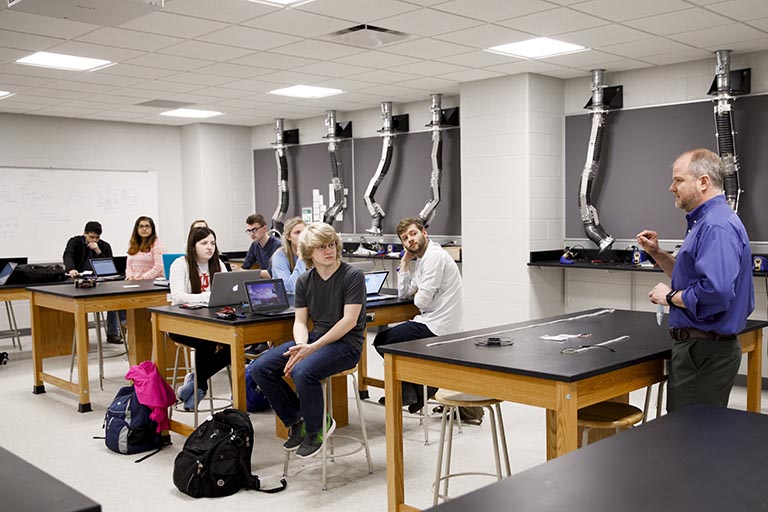Dear Friend of Indiana University:
Once again the end of an odd-numbered academic year coincides with the end of the Indiana General Assembly's budget-writing session. The budget that members of our state legislature just completed will set state appropriations for the next two academic years, including funding for Indiana University's operations, special programs IU carries out on behalf of the state, and capital projects.
Before getting into the details of the budget, I want to call special attention to the legislative leadership that helped craft the state's spending plan. The Statehouse has gone through a lot of transition over the past year or so, and many of these legislators are in new roles. Nevertheless, they maintained the consistent level of support for higher education that has been a hallmark of our state and has enabled Indiana's colleges and universities to meet the evolving needs of our students and our state's leading employers.
Special thanks are due to Rep. Todd Huston, the lead author of the budget bill and new Ways and Means Committee co-chair; Rep. Tim Brown, Ways and Means Committee co-chair; Sen. Ryan Mishler, new Appropriations Committee chairman; Rep. Brian Bosma, speaker of the House; Sen. Rod Bray, new Senate president pro tem; and Gov. Eric Holcomb. Additionally, I want to thank Rep. Bob Heaton, the Higher Education Subcommittee chair for Ways and Means; Rep. Holli Sullivan, the former Higher Education Subcommittee chair and continual advocate for higher education; and Indiana Commissioner for Higher Education Teresa Lubbers and her staff for their continued support.
Within this budget, the state provides a higher education operating increase over the base funding from 2019 of 1% and 2.5% in 2020 and 2021, respectively. However, IU will see an increase of 1.7% over fiscal year 2019 in the first year and 3.2% over FY 2019 in the second year. This is because a portion of each public institution's funding is awarded on a performance basis, and IU does very well on the performance metrics, which include criteria such as on-time degree completion.
Our regional campuses, in particular, did well on these metrics, which will result in increases of as much as 20.1% at our IU East campus in the second year of the budget. In total, the state will provide about $1.06 billion in operating funding to IU over the next two years — $26 million more than the base-year level of FY 2019.
This operating funding is supplemented with funding for eight special programs, including the Indiana Geological and Water Survey, the I-Light high-speed fiber optic research and education network, and the Indiana Institute on Disability and Community. Additionally, IU's Advance College Project, our dual-credit program for high school students, falls into this category and will see a 2.98% increase in funding. Total funding across all eight of these IU special programs totals $28 million over the next two years. Through these projects and others, IU is leveraging its vast array of knowledge, expertise and resources toward the educational, research and service needs of communities across our state.
Finally, in the capital portion of the budget, the General Assembly provided over the biennium nearly $100 million in funding in order for IU to continue to renovate, repair and maintain our world-class facilities on all seven of our campuses across Indiana. This includes $62 million for the IU Bicentennial Repair and Renovation project, which will be used for critically needed repairs and renovations of facilities and infrastructure at IU Bloomington and IUPUI; $8.1 million in Regional Campus Repair and Renovation funding; and nearly $29 million as part of the state's repair and renovation formula that applies to all public institutions.
After both chambers of the General Assembly passed the budget, Gov. Holcomb signed it into law last week. As we head into IU's Bicentennial, now just 56 days away, the consistent support we receive from our state's leaders reflects the confidence they have in our ability, as Indiana's flagship public university and its research powerhouse, to meet the most important challenges facing our communities, develop a strong and highly skilled Hoosier workforce, and ensure a high quality of life among all Hoosier residents.
This support also underscores the hard work of so many individuals who strive to ensure that our university community is centrally positioned to meet the needs of our state and its residents. Our success under Indiana's performance funding formula is testament to the strong leadership of Executive Vice President for University Academic Affairs John Applegate, IU Bloomington Provost and Executive Vice President Lauren Robel, Executive Vice President and IUPUI Chancellor Nasser Paydar, and many other academic officials.
Our stewardship of capital dollars and maintenance of our facilities by Vice President for Capital Planning and Facilities Tom Morrison ensures the state continues to view support for IU's capital projects and physical infrastructure as a solid investment. And IU's budget request has been worked on for over a year by Vice President and Chief Financial Officer John Sejdinaj and his colleagues at the University Budget Office, who ensure effective and efficient use of the financial resources with which we are entrusted.
Every unit at IU plays a role in confirming and reinforcing our reputation with legislators and helping us achieve the support for which we are most grateful. Of course, I would be remiss if I did not also give special thanks to Vice President for Government Relations Mike Sample, Vice President for Engagement Bill Stephan and our excellent state government relations team for shepherding our request through the legislative process.
And more generally, the consistent support we receive from our state reflects the hard work and dedication of our extraordinary faculty and staff, our outstanding students, and all of our alumni and friends across Indiana, our nation and our world who are committed to ensuring IU's greatness as the university prepares to embark upon a third century of excellence.
With many thanks,
Michael A. McRobbie
President, Indiana University



